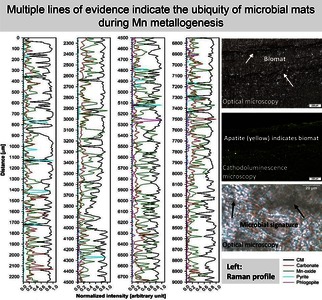Dong, Zhi Guo and Zhang, Bang Lu and Gyollai, Ildikó and Fintor, Krisztián and Szabó, Máté Zoltán and Kovács, Ivett and Gao, Jun and Zhang, Lian Chang and Polgári, Márta Piroska and Wang, Chang Le (2024) Microbial contribution to the formation of the Carboniferous sedimentary manganese deposits in northwestern China. ORE GEOLOGY REVIEWS, 170. No.-106124. ISSN 0169-1368
|
Text
DongZGetal_OreGeolRev_2024.pdf - Published Version Available under License Creative Commons Attribution Non-commercial No Derivatives. Download (25MB) | Preview |
|
![[img]](https://real.mtak.hu/222636/7.hassmallThumbnailVersion/1-s2.0-S0169136824002579-ga1_lrg.jpg)
|
Text (graphical abstract)
1-s2.0-S0169136824002579-ga1_lrg.jpg - Published Version Available under License Creative Commons Attribution Non-commercial No Derivatives. Download (264kB) | Preview |
Abstract
There is an increasing consensus that microbes play a critical role in the genesis of sedimentary manganese (Mn) carbonate deposits. However, compelling evidence for the microbial involvement during sedimentary Mn metallogenesis remains insufficient, and the specific effects of microbial mediation need to be further elucidated. To advance our understanding of the microbial Mn metallogenesis, multi-scale petrographic observations and high-resolution mineralogical analyses (mainly based on Fourier transform infrared spectrometer and Raman spectroscopy) were conducted on the Carboniferous black shale-hosted Malkansu and limestone-hosted Zhaosu Mn ore deposits in northwestern China. Results show that the Mn ore samples are characterized by finely laminated texture with μm-scale cyclic variations of microbe-associated minerals including rhodochrosite, apatite, quartz, and organic matter as well. These features indicate the ubiquity of microbial mats during Mn mineralization. Microbial involvement is also supported by Mn carbonate aggregates with variable morphologies (filamentous with pearl necklace-like inner forms resembling vermiform morphologies and spheroidal, coccoid-like forms), as well as the annular organic matter that resembles bacterial cells. The cyclic occurrence of trace amounts of remnant Mn oxides verify that primary Mn accumulation took place under oxic bottom waters. The negative co-variation between Mn carbonates and organic matter on Raman profiles suggests that the former was formed during diagenesis via organic matter decomposition coupled with Mn oxide reduction. Combined with previous experimental simulations and natural observations, a two-step microbially mediated Mn metallogenic model is tentatively proposed for the studied Mn deposits: (1) Mn(II)-oxidizing bacteria effectively catalyzed the deposition of considerable Mn oxides under oxygenated bottom water columns, a process that was simultaneously sustained by oxygenic microbial mats such as cyanobacteria; (2) Buried Mn oxides were reduced by highly reactive organic matter sourced from dead biomats of Mn(II)-oxidizing bacteria and benthic phototrophs, a process mediated by Mn(IV)-reducing bacteria which not only promoted the reaction rate but also served as nucleation sites for Mn carbonate minerals. This model can also help to explain the occurrence of diverse authigenic accessory minerals (e.g., quartz, apatite, and talc) and remarkable enrichments of several specific elements (e.g., Co, Ce, and Mo) in the studied Mn ores, which were closely linked to the decomposed cells and extracellular polymeric substance (EPS). By comparing with previous microbial investigations on Mn deposits over geological history, we further highlight the fundamental role of microorganisms in regulating the formation of economic Mn carbonate deposits.
| Item Type: | Article |
|---|---|
| Additional Information: | Key Laboratory of Mineral Resources, Institute of Geology and Geophysics, Chinese Academy of Sciences, Beijing, 100029, China Development and Research Center, China Geological Survey, Beijing, 100037, China Institute for Geological and Geochemical Research, HUN-REN Research Centre for Astronomy and Earth Sciences, Budapest, H-1112, Hungary CSFK, MTA Centre of Excellence, Budapest, H-1121, Hungary Department of Mineralogy, Geochemistry and Petrology, University of Szeged, Budapest, H-6722, Hungary College of Earth and Planetary Sciences, University of Chinese Academy of Sciences, Beijing, 100049, China Department of Natural Geography and Geoinformatics, Eszterházy Károly Catholic University, Eger, H-3300, Hungary Export Date: 03 May 2025; Cited By: 1; Correspondence Address: M. Polgári; Institute for Geological and Geochemical Research, HUN-REN Research Centre for Astronomy and Earth Sciences, Budapest, H-1112, Hungary; email: rodokrozit@gmail.com; C.-L. Wang; Key Laboratory of Mineral Resources, Institute of Geology and Geophysics, Chinese Academy of Sciences, Beijing, 100029, China; email: wangcl@mail.iggcas.ac.cn |
| Uncontrolled Keywords: | Microbial metallogenesis, Biosignatures, Mn carbonate deposits, Zhaosu, Malkansu, Carboniferous |
| Subjects: | Q Science / természettudomány > QE Geology / földtudományok |
| SWORD Depositor: | MTMT SWORD |
| Depositing User: | MTMT SWORD |
| Date Deposited: | 23 Aug 2025 16:19 |
| Last Modified: | 23 Aug 2025 16:19 |
| URI: | https://real.mtak.hu/id/eprint/222636 |
Actions (login required)
 |
Edit Item |




